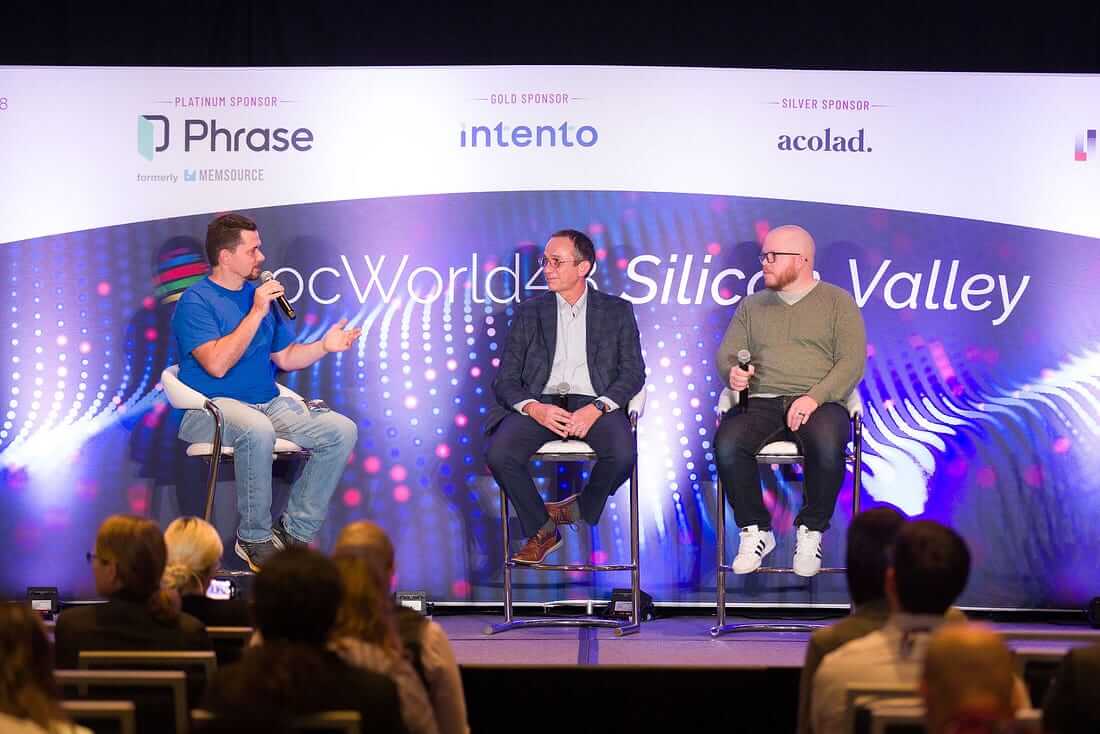We’re at an interesting inflection point in the translation industry. The technology to develop and enhance business processes is already here and works — but the industry itself is still catching up. It’s a once-in-a-lifetime opportunity if you’re able to recognize the potential.
There’s no specific profile of the ‘average’ MT user. Everyone from large enterprises to government organizations has begun to onboard the technology, and each organization can benefit from learning to overcome the initial hurdles when doing so.
At LocWorld 48 in Silicon Valley earlier this month, Intento Co-founder and CEO, Konstantin Savenkov, was joined by two MT veterans – Jeff Beatty (Executive Director, Project Management — Localization at Disney +) and Rolf Hecken (Manager outreach stakeholder engagement, Translation Bureau of Canada) – for a discussion about the industry shift toward MT, particularly on why it’s hard to embrace change and the success that often follows when you do.
Keep reading for a summary of their talk, including:
- Details on when it’s time to get started with MT
- The first baby steps toward a successful program
- Convincing your team, colleagues, and leadership to embrace MT
• • •
Deciding to get started in MT
A common factor leading to MT is a lack of human resources in the face of large volumes of content to be translated. This leads to an inflection of deadline delays and a burned-out workforce. As a government organization, the Translation Bureau of Canada has a mandatory obligation to provide top-quality translations for both official languages along with indigenous languages (about 350 million words/year) — but at the same time, they still have to maintain strict adherence to deadlines. In their case, the level of work to be done drove them to experiment more with MT, but after looking at the proof of concept, they found themselves very impressed with the results.
Even if you are a small enterprise, your ultimate goal is to grow and build a large customer base. These days that inevitably means globalizing to some extent. Eventually, the time will come when you either need to compensate for resource constraints (for example, the availability of translators) or increasing volumes. You’re not going to be able to slow down the content machine, no matter how much you’d like to.
“It’s not really a question of if you should get into that space; at some point, you are going to have to get into that space.” (Jeff Beaty, Disney +)
A specific tip from Jeff Beatty was to translate as much as you can, even into languages you don’t currently support. More translations mean more data, and so more translations will give fodder to new languages and customization down the road. Those assets become unrestricted to the localization process but can actually be leveraged in many other use cases across your company. Look at the initial MT process as an investment in that expansion.
• • •

• • •
Convincing your employees to embrace MT as a new tool
One element you may have to deal with is misinformation about the nature of AI and machine translation. Many companies need help with the workload and pressure their translators are under but don’t get help from machines because they’re worried about permanently replacing their translators. This isn’t the case. MT is a tool that can help your translators do their jobs more efficiently — not a replacement for their role altogether.
“We’re building a tool to help our translators get regular working hours.” (Rolf Hecken, Translation Bureau of Canada)
So, you might need to do a lot of mentoring to get your team to understand what machine translation will mean for your business case. For the Translation Bureau of Canada, this meant putting together a start-pack of proof of concepts to get employees to understand where they were heading.
To do this, they tackled the same project in two ways — once with just translators and then the same project, but this time Intento connected them to several stock engines. Training these engines for their specific use case gained them around 70% efficiency. That meant they could not only give their employees much-needed relief but also dip into the backlog without overloading the translators. Once your team saw these results, they began to ask to help improve the model even more with glossary support for specific terminology.
This shows that even if a team is hesitant at first, some exposure to the potential results will help get them enthusiastic about the benefits MT will yield once they own the product.
Convincing leadership or co-workers to help you work with MT
It’s no secret that there’s a stigma around MT. If your leadership or co-workers have never worked with MT, likely, they’ve at least heard of the stigma. Advocating for machine translation can be tough if your leadership returns generalized concerns rather than seeing the results for themselves.
One strategy around this is to spend the time to understand what exactly the concern is and to demonstrate specifically what is in your power with MT to avoid that outcome. Once that’s demonstrated, they will more often than not be interested in learning more about what can be done with MT. It’s especially effective when you can tie MT to solving a specific problem your business is experiencing — if you demonstrate MT will handle that pain point, it becomes much more appealing.
• • •
If you’re interested in taking the leap into MT, we’re here to help! For any further questions or a free consultation, book a meeting on our demo page.



